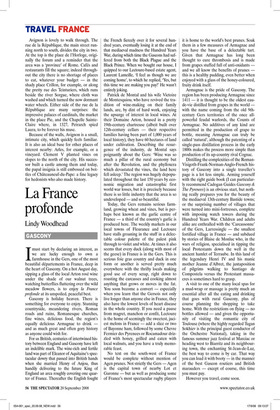All roads lead to Avignon
Sarah Carr-Gomm
AVIGNON
An expat in Australia was once asked what he missed most about England. ‘France,’ he replied. Reminded by this of what is on our doorstep, I took the weekly summer Eurostar from London to Avignon, which proved an ideal destination for a lover of fine weather, fine fare and lots of history.
The mediaeval traveller would have approached the walled city from the northwest via the Pont Saint-Bénezet, then the only bridge across the Rhône from Lyons to the sea, and made famous by the catchy French ditty. Built in the 12th century, it originally had an impressive 22 arches; only four survive. I have read that the song is not ‘sur le pont’ but ‘sous le pont’, supposedly sung by the thieves lurking underneath, who danced gleefully at the sight of potential victims entering the city. Certainly, if the cobblestones were anything like they are today, dancing on the bridge would surely have been injurious. The monumental crenellated ramparts of the Palais des Papes can be seen from afar. Soaring out of the rock, they suggest power and paranoia. Over a period of 100 years, seven popes and two anti-popes lived here, and it has since been known as the ‘City of the Popes’. In 1309 the first of these, Clement V, a Frenchman, abandoned anarchic, feuding Rome and moved the centre of the Christian world to the prosperous town at the crossroads of Flanders and the Mediterranean, and Spain and Italy. His successors expanded the Episcopal Palace with courtyards, grand audience chambers, private apartments and chapels, all built in less than 20 years. The modern visitor wanders through empty, cavernous halls, full of exposed masonry and massive fireplaces, scrubbed clean, where roaring fires must have battled to warm winters that could freeze the Rhône.
One can only imagine the luxury of the interior. There is no trace of the tapestries and silks that hung from the walls, the velvet carpets or beds covered in crimson and gold. All that remains are the frescoes in the Pope’s private apartments, painted by Sienese artists, depicting the kingly pursuits of hunting and fishing. With papal expenditure at ten times that of the royal court in Paris, the Popes lived in splendour; pity the sous-chefs at Clement VI’s coronation banquet, where 10,000 guests were served with 1,023 sheep, 118 cattle, 101 calves, 914 kids, 60 pigs, 10,471 hens, 1,440 geese, 300 pike, 46,856 cheeses and 50,000 tarts.
Such luxury brought decadence. Petrarch described the court as ‘a sewer where all the filth of the universe has gathered’, and Clement VI admitted to have lived as a ‘sinner among sinners’. Eventually, unable to resist simony and nepotism, nor control sybaritic cardinals, the papacy returned to Rome in 1403, since when no Pope has ever visited Avignon.
Other sites of Avignon include the Petit Palais, a must for devotees of Italian panel painting. Here are found nearly 1,000 fragments of large altarpieces, and Madonna and Childs galore with one sweet Botticelli in the crowd. The Musée Calvert, the city’s finest museum, has a broad collection, beautifully displayed, in a graceful 18thcentury palace. Its archaeological and sculpture collection is found at the Musée Lapidaire in a restored Jesuit church where the side chapels make ideal showcases. Several gothic churches reflect the papal presence. Some are bleak and grey, overlaid with baroque decoration, but at SaintPierre later architectural fashions sit in harmony with the old. Avignon is lovely to walk through. The rue de la République, the main street running north to south, divides the city in two. At the top is the place de l’Horloge, originally the forum and a reminder that the area was a ‘province’ of Rome. Cafés and restaurants fill the square; indeed throughout the city there is no shortage of places to eat, whatever your budget — in the shady place Crillon, for example, or along the pretty rue des Teinturiers, which runs beside the river Sorgue, where cloth was washed and which turned the now dormant water wheels. Either side of the rue de la République are many surprises: the impressive palaces of cardinals, the market in the place Pie, and the Chapelle SainteClaire where, in 1327, Petrarch spied Laura, to be forever his muse.
Because of the walls, Avignon is a small, intimate city, which quickly feels familiar. It is also an ideal base for other places of interest nearby: Arles, for example, or a vineyard. Clement V planted vines on slopes to the north of the city. His successor built a castle among them and today, the papal insignia is still embossed on bottles of Châteauneuf-du-Pape: a fine legacy for hedonists who also made history.











































































 Previous page
Previous page